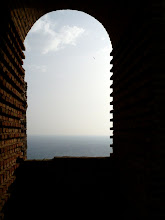
1.
"Anybody here a bike rider???"
Story Ideas: The benefits of commuting on bike--health, environmental, parking--versus the inconvenience of commuting on bike, such as flat tires, inclement weather, and spandex.
OR: Commuting on bike: the Dutch way of life. Explore mentalities, city systems, why you see elderly men in business suits commuting on bike over there compared to our mental picture of college-students or people in neon spandex. Could be compared to California commuting habits
Fiction Idea (:
A Dutch man in his late-50s has recently lost his wife. Although they separated 2 years previous, he is devastated. He tries to cope by exploring Holland via bicycle, and early-on decides to write a guide to the intercity bike paths that includes the best places to stop for gebakje and koffie (Dutch pastries and coffee,) as well as brief descriptions of the best pubs and historical sites. He unwittingly gravitates toward the places that he spent time with his late wife. The written journey through Holland parallels the story of how he met his wife, their courtship, the different cities they visited through the years as they raised 2 children together, and their late separation.
Could culminate in:
A revelation of how alive she really is to him, despite the fact that she's no longer physically alive, and despite the misunderstanding that shadowed the last few years they were together. "I see her in the flowers of the Bloemstraat. In the cafes shadowing the canal. In Delft's squares, and Utrecht's corners, and Amsterdam's busy markets and hollow cathedrals." Could include his realization that the history he has been writing actually has been about his life with her--in a symbolic way--or not.
OR:
A physical condition renders him unable to bike. But he's so attached to the project that he can't bear to give it up. So he goes to the Hostel Jordaan in Amsterdam. "Anybody here a bike rider?" Meets a young American girl who has recently lost her Dutch aunt to cancer and is in Holland over the summer with her aunt's diary trying to "discover" her. The aunt lived in Holland before the girl was born. She volunteers to take him through the cities, (they have bike-"taxis" there, but hiring one would be expensive,) to help him finish his book. She cancels her return trip, and ends up spending several months in Holland, since he has offered bed-and-board.
Character development: She starts out bitter and frustrated with her life and her aunt's death; he is reluctant to talk about he and his late wife's problems, and won't even mention that they were separated. They both "discover" their dead loved-ones in the journey through the cities, and open up and become friends/begin to heal in the process.
Note: would have to be handled carefully to not be cliche and/or sickly-sweet
(And yes: I always try to ground my writings in something personal....)
2.
"I'm majoring in philosophy....it will help me go in to my field...."
"Oh! What field are you going in to?"
"I'm going to rule the world."
Could culminate in:
A revelation of how alive she really is to him, despite the fact that she's no longer physically alive, and despite the misunderstanding that shadowed the last few years they were together. "I see her in the flowers of the Bloemstraat. In the cafes shadowing the canal. In Delft's squares, and Utrecht's corners, and Amsterdam's busy markets and hollow cathedrals." Could include his realization that the history he has been writing actually has been about his life with her--in a symbolic way--or not.
OR:
A physical condition renders him unable to bike. But he's so attached to the project that he can't bear to give it up. So he goes to the Hostel Jordaan in Amsterdam. "Anybody here a bike rider?" Meets a young American girl who has recently lost her Dutch aunt to cancer and is in Holland over the summer with her aunt's diary trying to "discover" her. The aunt lived in Holland before the girl was born. She volunteers to take him through the cities, (they have bike-"taxis" there, but hiring one would be expensive,) to help him finish his book. She cancels her return trip, and ends up spending several months in Holland, since he has offered bed-and-board.
Character development: She starts out bitter and frustrated with her life and her aunt's death; he is reluctant to talk about he and his late wife's problems, and won't even mention that they were separated. They both "discover" their dead loved-ones in the journey through the cities, and open up and become friends/begin to heal in the process.
Note: would have to be handled carefully to not be cliche and/or sickly-sweet
(And yes: I always try to ground my writings in something personal....)
2.
"I'm majoring in philosophy....it will help me go in to my field...."
"Oh! What field are you going in to?"
"I'm going to rule the world."
Story Ideas:
Why students major in what they major in. Image, jobs, parents, friends, and other influences. Cal Poly specifically or the CSU system overall.
OR: Stereo-typing of majors. Computer-science "nerds" and lazy business majors.
Possible plots:
He's just your average, happy-go-lucky barista. Working his way through school. Partying with the guys. Hitting up Chili Peppers at 3am. Avoiding a clean room or actually reading his textbooks with as much vehemence as the best of his World of Warcraft-playing buddies. With one exception: he actually plans to rule the world. And he'll do anything to get there.
(Unique twists: protagonist applies philosophical theories to everything, from the best way to do laundry to the particular route he plans to take in achieving world domination.
Note: Must be handled very seriously and matter-of-factly to achieve the full ludicrous effect. Also, it would have to be handled very carefully and with enough attention to detail/character development that it could stand on its own as a tale about college life.)
3.
"...Is that really bad? But it's for a manager's position, which has a lot more pay for not as many hours. I don't know.....I'm nervous now. Really nervous. It wouldn't be good. It would be bad. I don't know...I'd get in trouble. I think i'm going to go in to the store across this store and try and look for....something."
Story ideas: Shifting morals in the corporate world.
OR: "How-To" tips for getting a job when you get out of school. (Focus audience the college-aged crowd.)
OR: Ways we deal with stress: shopping, denial, sugar, etc. Compare to ways we SHOULD deal with stress: nutrition, sleep, friends, quiet time, and exercise.
Possible plots:
He's an English major whose been out of school for 6 months. He can't find a "real" job, and has had to move back in with his Reformed Baptist parents who live in downtown San Luis Obispo. His little sister's already found a position with an editor in San Francisco. His girlfriend's a Type-A mechanical engineering junior who doesn't get why he can't find work. OR why he majored in English in the first place. Story opens with her trying to convince him over the phone to go back to school: something he desperately doesn't want to do. His rebuttal is that he has the chance to get a manager's position at Downtown Brew, but he'd have to "edit" his birth certificate to put him over 21.
4.
"Look for me in 14 or so years running under the Clothing-Is-Optional party."
Story Idea: Candidates' shifting moral base: what lengths politicians will go to to appeal to the masses
Possible Plot:
He didn't want to go to Harvard. He doesn't want anything to do with politics. But as the only son of a line of famous senators, there isn't much chance to do anything else. At least, not while his parents are alive. Or know what continent he is on. The 17-year-old first-year Harvard student decides to "turn off" his Type-A nature and learn how to be a gracefully incompetent and barely average student. Leave his laundry on the floor; actually--gasp--skip a few classes. Hopefully then his parents will give up on him. The problem is, he's not just fighting his parents: he's fighting his own personality.
5.
"Um. I don't know. Cuz that's what they said that they were looking for. I don't know. It seemed like it went really well. It was really short and...ya.... Which was wierd. You know what I mean?.... I'm all nervous now! Now I'm thinking of everything I did! Now I'm thinking I did it all wrong."
Story Ideas: Suggestions for a successful interview. What's good; what's bad; what's in-between. What bosses are looking for, from wardrobe to attitude to word choice.
OR: Cell phone etiquette in public places....
Possible plot:
Definitely a neurotic. A neurotic, out-of-work, 20-something-year-old therapist. With a passion for collecting orchids and cooking Italian food. Her life collides with that of a returning Iraq-war veteran with post-traumatic stress disorder when the 24-year-old veteran responds to the therapist's online ad. The therapist puts on a professional front with her clients, and has been successful in fooling them.... until she meets the veteran. He sees through her ruse, picks up on her neuroticism, but can't afford a "real" therapist and promised his girlfriend he'd see one; the therapist can't afford to drop him. He ends up counseling the therapist using the same experiences in Iraq that bothered him--which also helps him work through them. He also drops the pushy girlfriend (somewhat helped by her discovery that the therapist is female.) At his suggestion, the therapist starts a nursery for rare flowers and finally puts her neurotic attention to detail to good use.
Romance optional.















